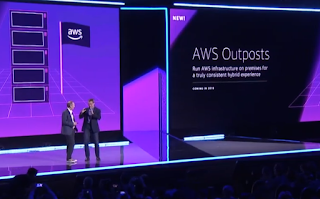Andy Jassy will take over as Chief Executive Officer of Amazon in Q3 2021, replacing Jeff Bezos who will transition to the role of Executive Chair.
Jassy, who currently serves as CEO of Amazon Web Services (AWS), has played a key role in the development of cloud services.
Some highlights for AWS for Q4 2020:
- AWS announced new commitments and migrations spanning major industries, including financial services with JPMorgan Chase, Itaú Unibanco (Latin America’s largest bank), Standard Chartered Bank, and Nationwide; media and entertainment with Metro-Goldwyn-Mayer (MGM), Thomson Reuters, and ViacomCBS; technology with Arm and Twitter; travel with Boom Technology, Inc. (Boom Supersonic) and Star Alliance (the world’s largest airline alliance); retail and e-commerce with Mercado Libre (Latin America’s largest online commerce and payments provider) and Zalando (Europe’s largest online fashion and lifestyle platform); power and utilities with Siemens Smart Infrastructure (a Siemens AG business group that focuses on energy distribution and intelligent buildings); and automotive with The BMW Group, as well as a multi-year, global agreement to develop and market BlackBerry’s Intelligent Vehicle Data Platform, IVY.
- AWS continued to expand its infrastructure footprint around the world, announcing the AWS Asia Pacific (Hyderabad) Region, available by mid-2022, and the AWS Europe (Zurich) Region and AWS Asia Pacific (Melbourne) Regions, available in the second half of 2022.
- AWS provides 77 Availability Zones (AZs) within 24 geographic regions, with announced plans for 18 more Availability Zones in six more AWS Regions, including regions in Indonesia, Japan, and Spain, as well as the recently pre-announced regions in India, Switzerland, and Australia.
- New AWS Local Zones in Boston, Houston, and Miami place AWS infrastructure close to end users in metropolitan centers, so customers can access low-latency compute, storage, and database services without needing to provision or maintain datacenter space. AWS also announced the availability of AWS Local Zones in 12 additional cities (Atlanta, Chicago, Dallas, Denver, Kansas City, Las Vegas, Minneapolis, New York, Philadelphia, Phoenix, Portland, and Seattle) coming in 2021.
- AWS announced two new smaller AWS Outposts form factors (1U and 2U servers) that give customers access to AWS on-premises in space-constrained locations, such as branch offices, factories, hospitals, cell towers, or retail stores.
- Introduced first cloud-based Mac instances (EC2 Mac instances for Amazon Elastic Compute Cloud).
- Introduced five new EC2 compute services, including Graviton2-powered C6gn instances that provide 40% better price performance for networking and compute-intensive workloads over comparable current generation x86-based instances, AMD-powered G4ad Graphics Processing Unit (GPU) instances that offer the industry’s best price performance for graphics-intensive applications, M5zn instances that deliver the fastest Intel Xeon Scalable processors in the cloud, Intel-powered D3/D3en instances that offer the highest storage capacity for local HDD storage in the cloud, and memory-optimized R5b instances that deliver the fastest block storage performance available for Amazon EC2.
- Introduced nine new capabilities for Amazon SageMaker that make it even easier for developers and data scientists to prepare, build, train, deploy, and manage machine learning models.
- Introduced five new services for industrial customers that use machine learning to improve operational efficiency, quality control, security, and workplace safety. Amazon Monitron and
- Introduced Amazon EBS io2 Block Express volumes, which deliver the first storage area network (SAN) built for the cloud, with up to 256,000 input/output operations per second (IOPS), 4,000 MB/second throughput, and 64 TB of capacity.
- Introduced four new container services to help customers develop, deploy, and scale modern applications in the cloud and on-premises: Amazon Elastic Container Service (ECS) Anywhere and Amazon Elastic Kubernetes Service (EKS) Anywhere enable customers to run Amazon ECS and Amazon EKS in their own data centers, AWS Proton automates container and serverless application development and deployment, and Amazon Elastic Container Registry (Amazon ECR) Public provides developers an easy and highly available way to share and deploy container software publicly.
- The next version of Aurora Serverless, Aurora Serverless v2, scales to hundreds of thousands of database transactions in a fraction of a second, delivering up to 90% cost savings compared to provisioning infrastructure for peak capacity.
- Introduced AWS announced the general availability of Amazon EC2 P4d instances, the next generation of accelerated computing instances powered by NVIDIA A100 Tensor Core GPUs and AWS petabit-scale networking. P4d instances provide up to 3x faster time to train and 60% lower cost than previous generation instances for machine learning training and high-performance computing in the cloud. EC2 P4d instances are also the only instances in the cloud to feature UltraCluster capability, enabling customers to scale to 2x the computing power as any other cloud provider.
- AWS announced AWS Trainium, an AWS-designed machine learning training chip that will deliver the most cost-effective training in the cloud. AWS Trainium will deliver the most teraflops of any machine learning training instance in the cloud, support all major frameworks (including TensorFlow, PytTorch, and MXnet), and use the same Neuron SDK used by AWS Inferentia (an AWS-designed chip for machine learning inference acceleration), making it easy for customers to get started training quickly with AWS Trainium. AWS Trainium is coming to Amazon EC2 and Amazon SageMaker in the second half of 2021.












